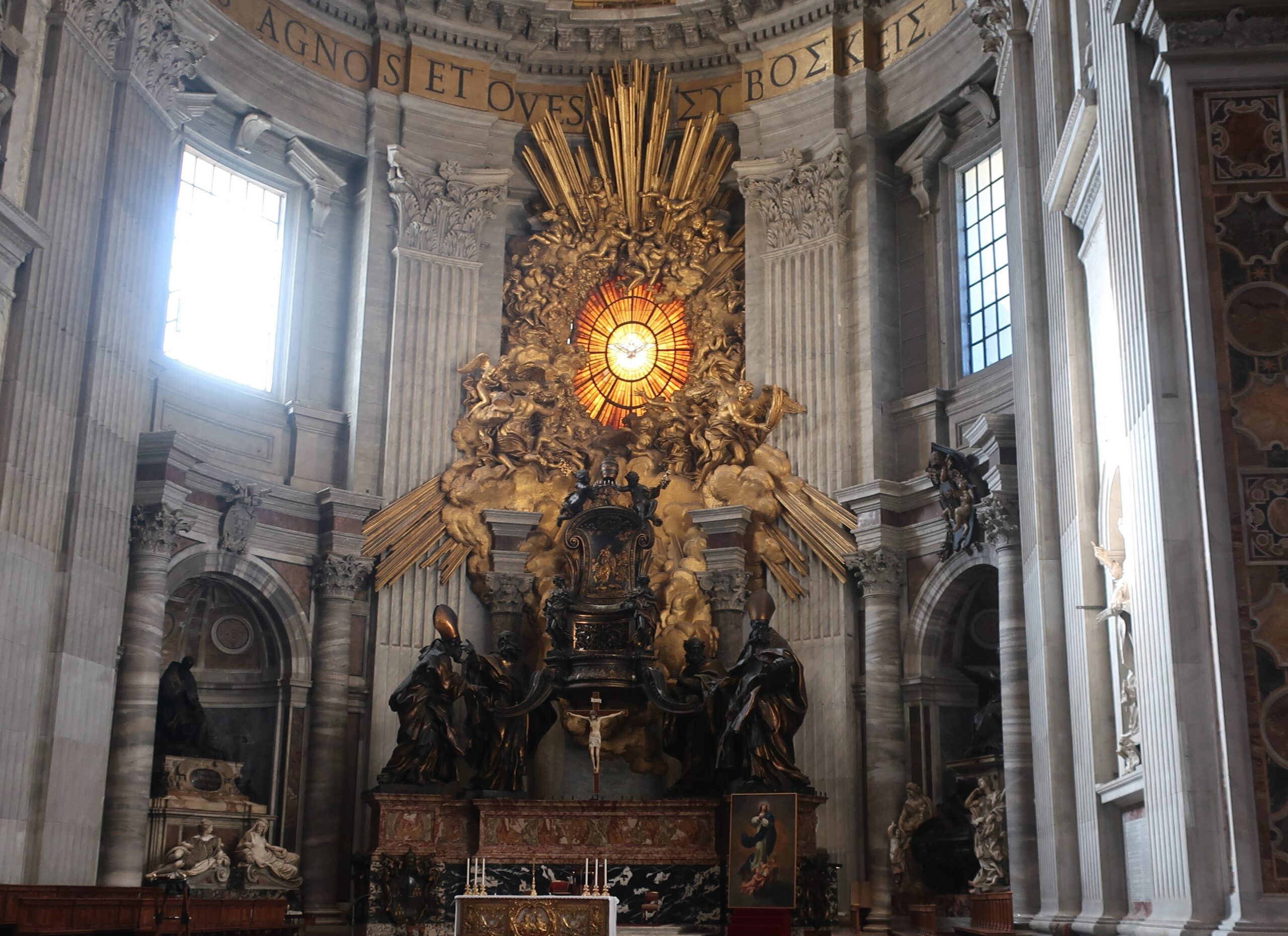Table of Contents
- 1 Travels in Rome] (37) "Catedra Petri" in St. Peter's Basilica - The culmination of Bernini's art! An astonishing masterpiece that incorporates the space itself into the work!
- 1.1 What is "Catedra Petri"?
- 1.2 Bernini's production of Cathedra Petri
- 1.3 Peter's episcopate supported by four church doctors
- 1.4 Bernini's religious exuberance to the point of fervor and magical figurative power appeared in his later years.
- 1.5 What is Bernini's unique talent that enables him to complete a major project?
- 1.6 Tomb of Alexander VII - the Pope who supported Bernini's second golden age
- 1.7 Tomb of John Paul II
Travels in Rome] (37) "Catedra Petri" in St. Peter's Basilica - The culmination of Bernini's art! An astonishing masterpiece that incorporates the space itself into the work!
In the previous and previous articles.St. Peter's SquareandScala Regia.introduced.
In this article, we will finally introduce "Cathedra Petri" inside St. Peter's Basilica.
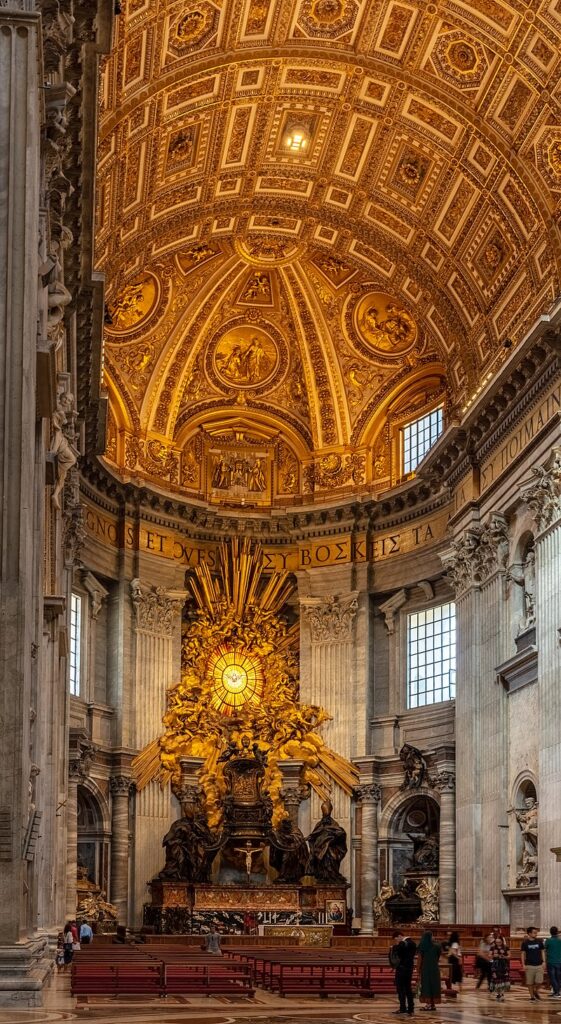
What is "Catedra Petri"?
By the way, going back a bit, while the construction of the square is going on, in St. Peter'sreserve troopsThe important task of decorating the It was St. Peter'sthe episcopal seatThe decoration is centered on the "Catedra Petri" (Peter's Bishop's Seat), commonly called the "Catedra Petri" (Peter's Bishop's Seat). A bishop's chair is literally a chair in which a bishop sits, and St. Peter's, the first bishop of Rome, was preserved in St. Peter's. This oak bishop's chair with ivory decorations was built in 1969, when St. Peter's was the first bishop of Rome. The ivory-decorated oak bishop's throne was actually made in the ninth century and given to the pope by Charles the Bald (d. 877), according to research conducted in 1968/69. For a long time, however, it was believed to have originated at least in part from the bishopric of St. Peter, and was revered. Especially for the Catholic Church, which advocated a new "triumph of the Church" through the Counter-Reformation, Peter's bishopric was seen as a precious relic that demonstrated the authority of the pope as Christ's representative.
At the time of Alexander VII's accession to the throne, this bishop's seat was enshrined on the altar established by Urbanus VIII in 1639. However, when seen in the prints of the same period, this altar is rather mediocre. Alexander VII was not satisfied with this, and decided to decorate the apse with a bishopric in 1656. The idea of decorating the apse with a bishop's throne was not only to exalt this relic of great symbolic significance, but also to revive the tradition of the early Christian Church of placing the bishop's throne at the back of the apse.
Masumi Ishinabe, Yoshikawa KobunkanBernini, Giant Star of Baroque Art.p162-163
*some line breaks.
Although the bishop's seat in St. Peter's Basilica was discovered in 1968/9 to actually be from the 9th century, the significance of the bishop's seat is still not lost at all. It lives on as a symbol in the faith. Bernini's task was to find a way to elevate this bishop's seat of such immense significance to a higher level of glory.
Let's continue to look at this "Cathedra Petri".
Bernini's production of Cathedra Petri
in 1657the Sacred MinistryThe first plan that Bernini drew up at the request of the "Catedra Petri" was very small and meek compared to the Catedra Petri that we see today. This was done in harmony with the tombs of Paulus III and Urbanus VIII on either side of the apse, so that the entireniche (in Western architecture)The reason for this is that the old St. Peter's was made to fit into the old St. Peter's, as seen in this first plan.the episcopal seatto the bronze.the episcopal seatThe basic motif of the "church" is the same until the very end, with the four church doctors supporting it.
However, Bernini changed his plan twice, each time expanding the scale of the project. This change of plan is very suggestive, as it conveys well Bernini's conception and production process. The first plan, which emphasized balance and cohesion, was austere and even grandiose, but after two changes, it became dynamic, dramatic, spiritual, and grandiose.showIt was transformed into a
This process of transformation reminds me of Santa Maria del Popolo's Daniel. In other words, the process of Daniel's transformation from an ancient form of the Father in the Laocoon group to a Baroque work with a mysterious religious quality. In both cases, the basis of such a process is the religious nature of Bernini's work and theplayThe aesthetic of the form and the aesthetic of the form are at work.
In the case of Cathedra Petri, too, the most important thing for Bernini, who decided on the final proposal, was to ensure that the work would be placed where it was actually going to be placed, and that it would be in the right place.performingThe effect was a "wow" effect. As the wonderful drawings in the Vatican Library show, he designed Baldacchino to frame the cathedra, so to speak, when viewed from the entrance of the church, capturing the image that had flashed in his mind. To this end, the plan was progressively expanded to find a more appropriate balance with the baldacchino.
Thus abandoning the first plan, Bernini took on the second and had a life-size model of the tree made in 1658 to study its effect in the field, and the biographer Pascoli's biography of the painter Andrea Sacchi suggests that this was the time of his critique. Sacchi, who represented the classical tendency in painting in the first half of the 17th century, did not have much association with Bellini, but he visited St. Peter's when asked for his opinion on this work. When Bernini led him to the middle of the nave, he said that this was the point where the work should be seen, and he left with only one comment: "This sculpture needs to be one Palmo bigger. Whether or not he accepted Sacchi's comment, Bernini further increased the scale of the project from 160 to 61, and this was the final plan.
Masumi Ishinabe, Yoshikawa KobunkanBernini, Giant Star of Baroque Art.p164-165
*some line breaks.
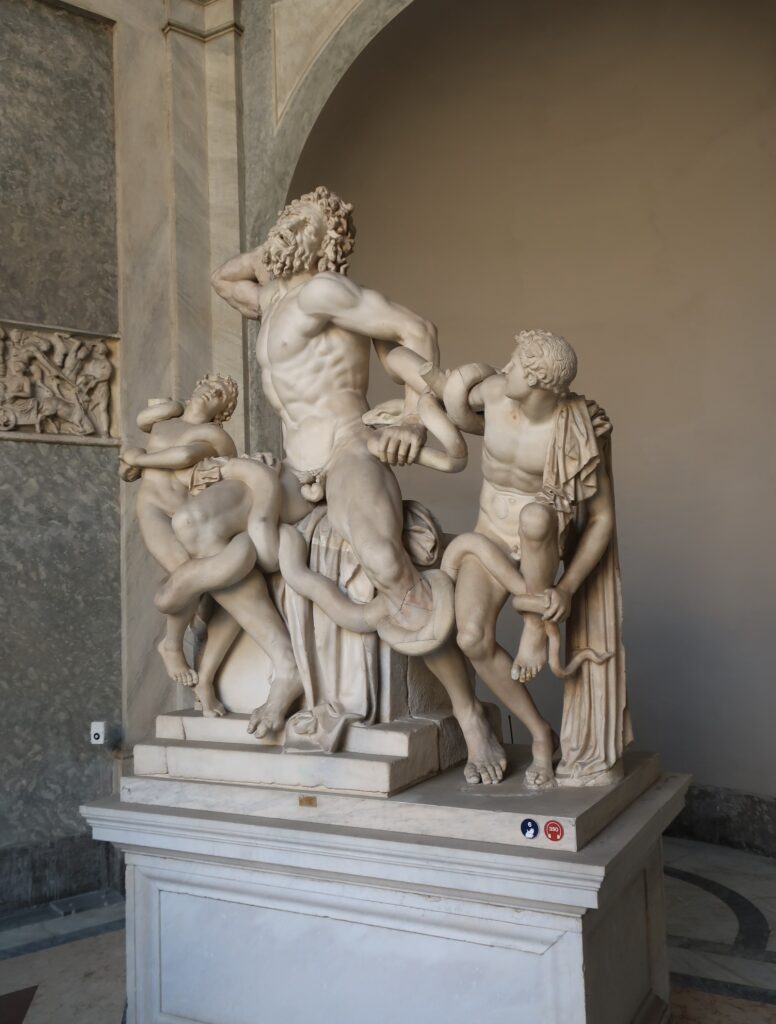
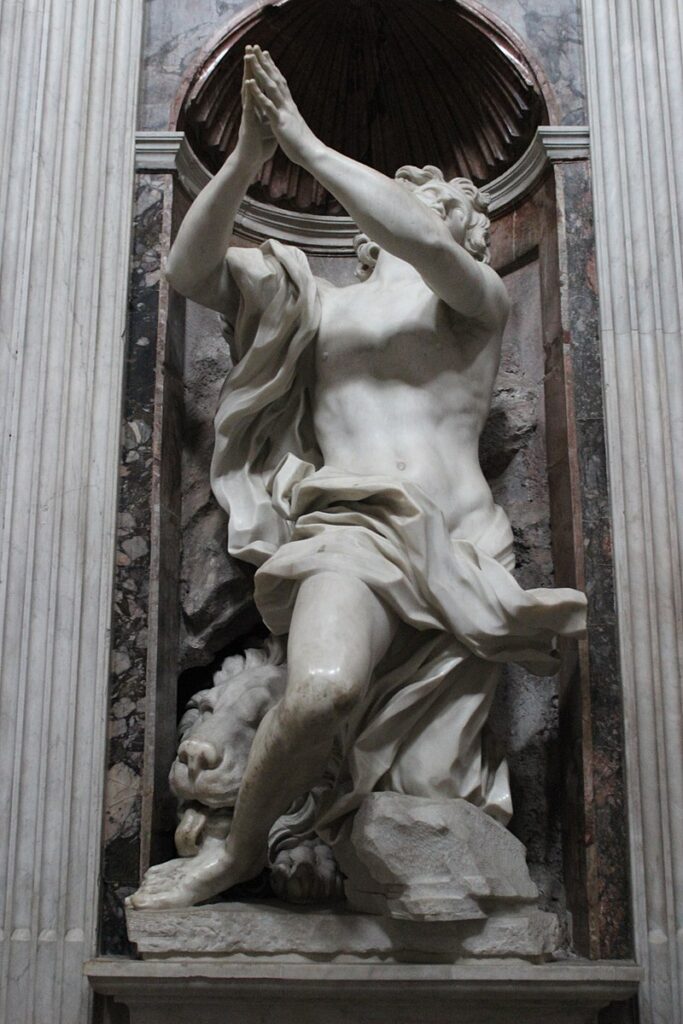
On the left is "Laocoon" and on the right is "Daniel. Bernini used ancient art as a reference when creating "Daniel" for the Pheasant Chapel in the Church of Santa Maria del Popolo. (For more information.(31) Statues of Daniel and Habakkuk in the Church of Santa Maria del Popolo: Bernini's Mystique and Ancient Roman Inspiration."(See article in)
In the case of "Cathedra Petri," Bernini started out with a simple idea, and then gradually developed a religious mystique. The point is that even Bernini, as one would expect, is not able to create something as creative as the final proposal out of the blue.
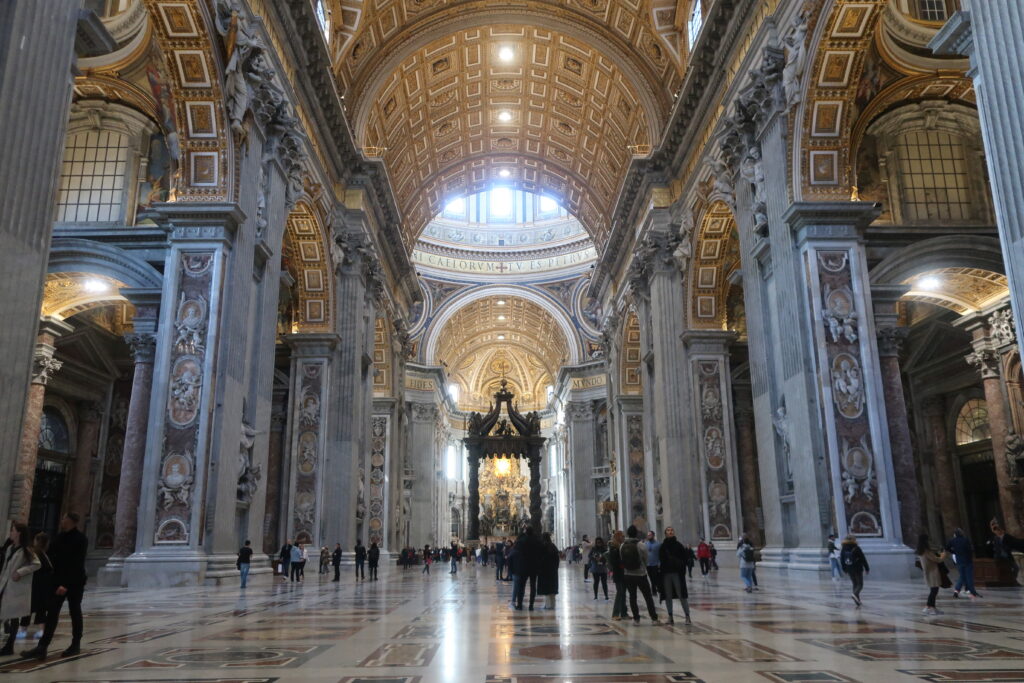
This photo was taken from around the center of the nave of St. Peter's Basilica. The "Catedra Petri" can be seen on the other side of the Baldacchino from here.
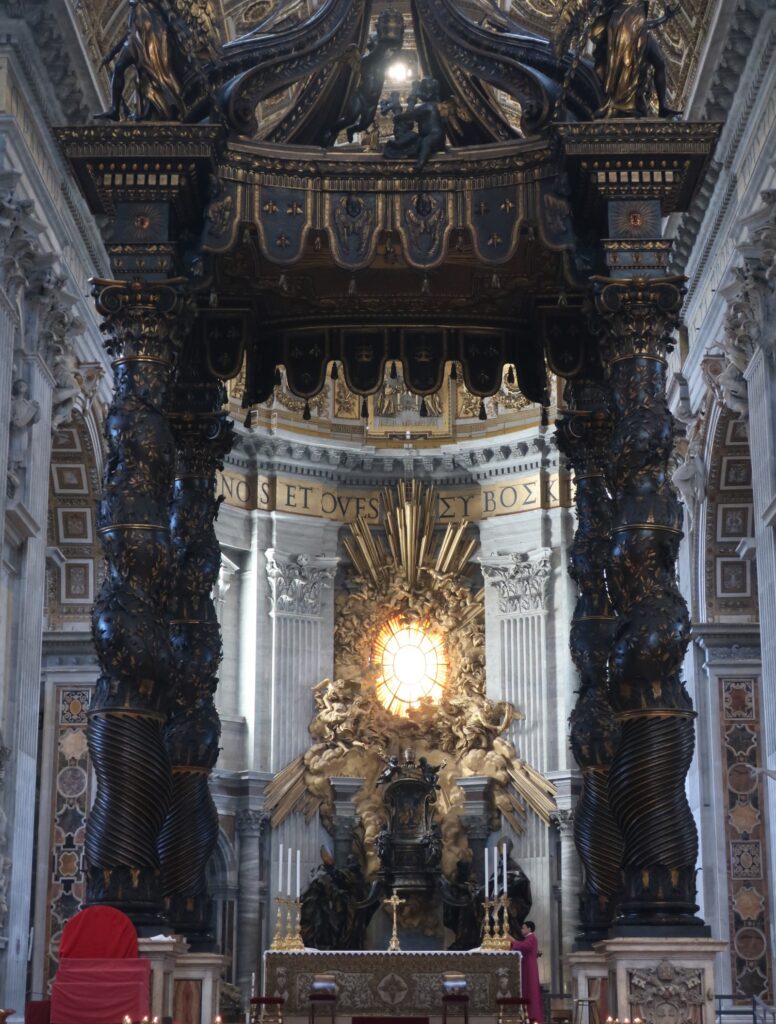
Taken from near Baldacchino. You can see exactly how the black columns of Baldacchino serve as a picture frame.
Peter's episcopate supported by four church doctors
This cathedra petri has a colored marble base and four bronze church doctors, supported by four of them, and St. Peter.the episcopal seatand a glass painting of the Holy Spirit in stucco and bronze.gloryIt is composed of the following two elements. The bronze bishop's seat, the centerpiece of this decoration, houses the old bishop's seat of St. Peter inside. Thus, this entire decoration is onerelicThe relics of the bishop are the "relics" of the bishopric. Then, in order to convey the meaning of this relic, the back of the bishop's throne is marked with "Feed my lambs.It is not surprising that the "Bishop's Crown" is represented, and at the top, Putto is holding the bishop's crown as a tribute. The four church doctors supporting the bishop's throne, a precious relic, are St. Ambrose in the front left, St. Augustine in the right, St. Athanasius in the rear left, and St. Chrysostomus in the right. Two of the four are doctors of the Western Church, but the bishop-crowned ones are placed at the front, where they are more important.
It should be noted here that these four doctors are not supporting and holding the bishopric in a physical sense. They are merely holding on to the ribbon of the bishop's throne, which is suspended in the Mystical Ka. In other words, their support is both spiritual and secondary. The Holy Spirit descends on this bishop's throne, surrounded by angels and putti flying in praise of the glory of God. Light and clouds cover the building, and the bishop's throne is suspended in the air, enveloped by the clouds.
Masumi Ishinabe, Yoshikawa KobunkanBernini, Giant Star of Baroque Art.p165-166
*some line breaks.
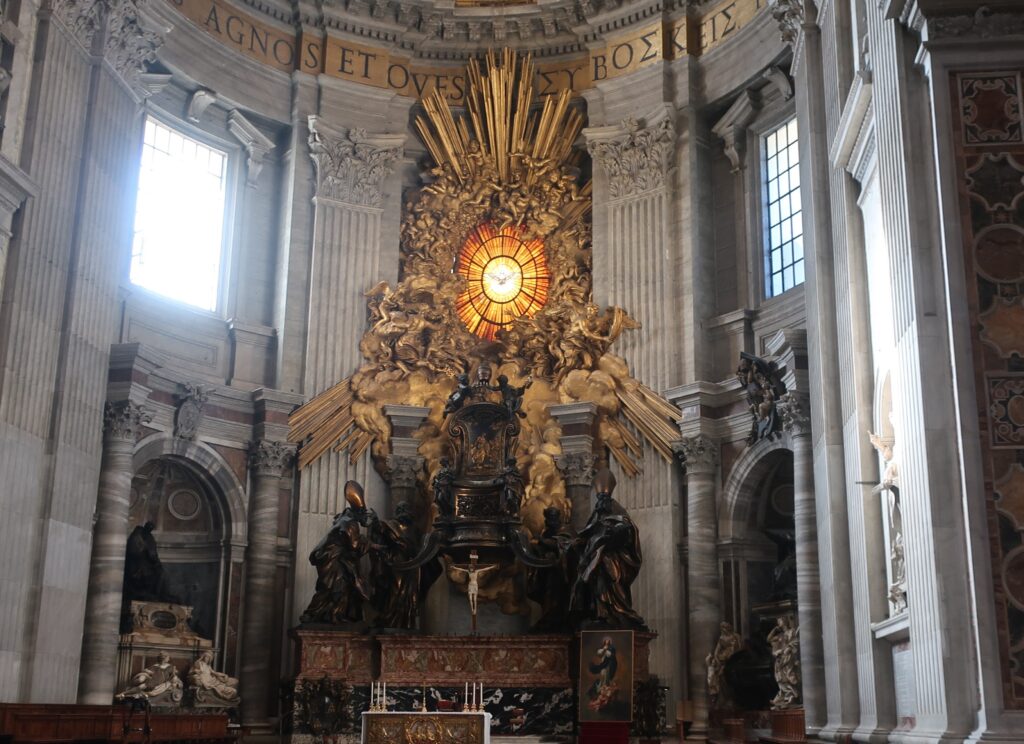
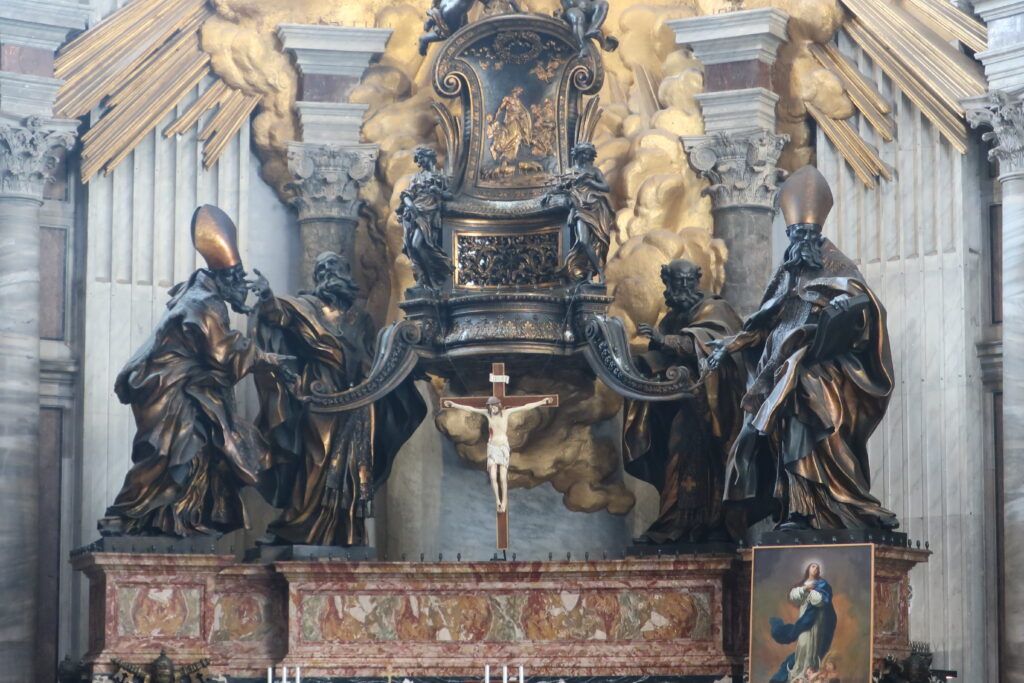
It is worth noting here that these four doctors are not holding the bishopric up in a physical sense. They are merely holding on to the ribbon of the bishop's throne, which is suspended in the Mystical Ka. In other words, their support is both spiritual and secondary. The Holy Spirit descends on this bishop's throne, surrounded by angels and putti flying in praise of the glory of God. Light and clouds cover the building, and the bishop's throne is suspended in the air, enveloped by the clouds."
Indeed, if you look closely, you will see that these church doctors are not physically supporting this bishopric. They are really just pinching a little ribbon. You may not notice this until you are told, but as Masumi Ishinabe states, I think this has an important meaning.
Bernini's religious exuberance to the point of fervor and magical figurative power appeared in his later years.
Cathedra Petri was the culmination of a long period of work by Bernini. It is the culmination of a long career of Bernini's work, in which his conception of art developed on a tremendous scale. It is not only an amalgam of various materials and techniques, but also an integration with the architecture that serves as its environment, meaning that the overall pictorial effect is the main focus of his work.
In fact, when viewed from the nave through the baldacchino, the decoration looks like a heavenly painting. On SiteperformingIt is almost as if Bernini, in his search for the most effective way to create a new form of art, had finally turned the whole of St. Peter's into an exhibition space for Catedra Petri. At the very least, it is clear that with this work, Bernini has given visual and religious significance to the long, enormous space of St. Peter's. The work is not only about form, but also about light, color, and texture. In this work, the sensory evocative power of light, color, and texture, as well as form, is utilized from all angles to lure us out of reality and into a world of religious fantasy. In other words, Bernini's magician-like figurative power allows us to experience the mysticism of the Baroque.visual hallucinationis beautifully visualized. And this visionary scene, like, for example, the Quarantore staged by Bernini in the Chapel of Paolina,festivalsIt is reminiscent of a scene from It is, indeed, the culmination of a magnificent Baroque celebration.
But the source of the work's evocative power lies deeper. As is especially evident in the Four Doctors of the Churchwildly enthusiasticThe work expresses a religious exaltation to such an extent that it well conveys the state of mind that Bernini had reached in his later years. Without this inner tension, this huge and extravagant ornament would not have had the same formative power and evocative power. Bernini himself also painted the Cathedra Petri and the Piazza San Pietro as his lifetime masterpiece.pillared corridorHe was attached to the
Masumi Ishinabe, Yoshikawa KobunkanBernini, Giant Star of Baroque Art.p166-167
*some line breaks.

In fact, when viewed from the nave through the baldacchino, the decoration looks like a heavenly painting. On siteperformingOne would think that Bernini, in his search for effects, had finally turned the entire St. Peter's into an exhibition hall for Catedra Petri."
Bernini incorporates not only his sculptures but also the space itself into his works. The ultimate example of this is Baldacchino and "Cathedra Petri!
What is Bernini's unique talent that enables him to complete a major project?
The Cathedra Petri took nearly 10 years to complete. This is because this was the largest project in the works of Bernini, who usually employed many assistants. The number of artists who collaborated on the work under Bernini's direction numbered 35, including many of the most prominent artists in Rome at the time. Despite the "many hands" involved, however, every detail of this work shows the attention to detail that was so important to Bernini.
He would have his assistants master the concept through drawing, then clarify the details and make models for the important parts of the work. In this way, no one can compare to Bellini in his ability to use his assistants at will to create his own works of art. Cathedra Petri is the best proof of this.
For example, Puttu and the angels soar over "ThegloryThe decoration of the "Cathedra Petri," both in its entirety and in its details, is full of beauty and tension, far surpassing the countless stucco decorations of this type found in many other places. The Cathedra Petri also required a large amount of bronze, though not as much as the Baldacchino. For this reason, the authorities sought the material first in Amsterdam and Venice, and later in Trieste and Hungary. Not only the cost of the bronzes, but also all other expenses were increased by the two expansions of the project. The completion of the work therefore cost more than 160,000 scudi, but it was thanks to the Pope's great confidence in Bernini that he was able to produce the work as he wanted it to be.
In other words, the two great projects of the Colonnade and Catedra Petri were made possible by the Pope's complete trust in Bernini and his ability as an artist and a human being to use his collaborators at will. The execution of such a great undertaking could never have been achieved by Michelangelo, who was a solitary man, or by Boccolomini, who was always in trouble with his patrons.
Masumi Ishinabe, Yoshikawa KobunkanBernini, Giant Star of Baroque Art.p167-168
*some line breaks.
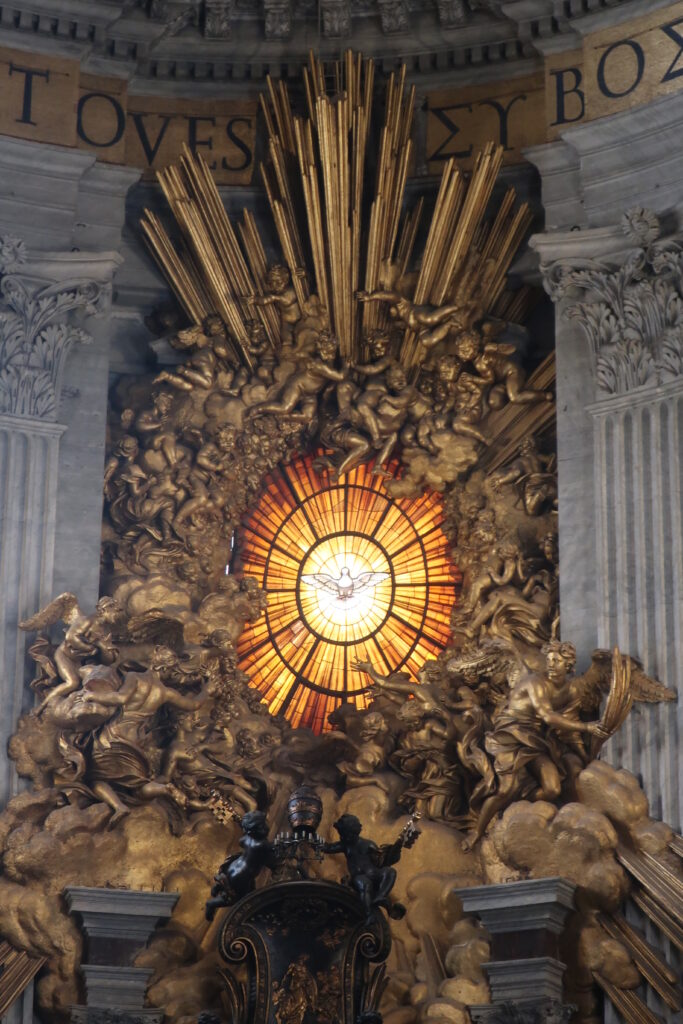
The execution of such an undertaking was something that neither Michelangelo, the lone man, nor Boㇽromini, who always had problems with his patrons, could ever have duplicated."
It boils down to this. This is an extremely important point when considering Bernini's personality. Bernini had the qualities of a team leader. He also had the skills to get along with his patrons and many departments. This goes far beyond mere sycophancy or sycophancy. He was a witty and communicative man. Popes and cardinals were the most educated men of their time. He had the intellect to talk with such people on equal terms.
In other words, Bernini was a "versatile man" of a different type from Leonardo da Vinci. One cannot help but be impressed by this. It is because of such a great genius that we have the "Hall of Beauty in Rome. It is because of him that Rome is so beautiful that we are able to admire it.
I would like to conclude this article by introducing the tombs of Alexander VII and John Paul II in St. Peter's Basilica.
Tomb of Alexander VII - the Pope who supported Bernini's second golden age
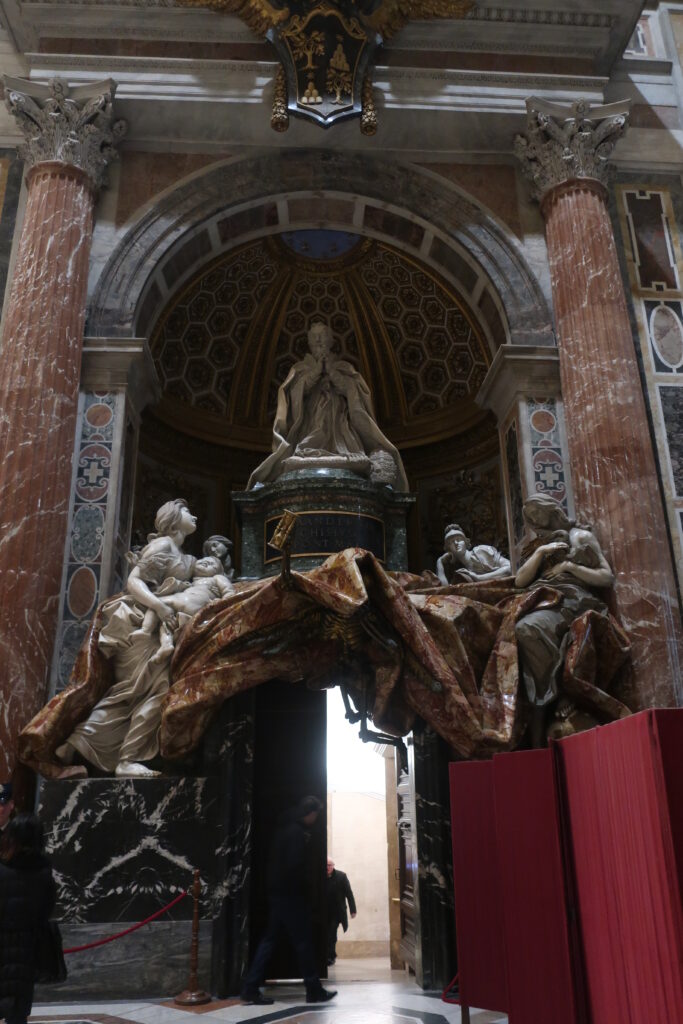
It's a tomb, but it's floating in the air! I was astonished when I saw this work for the first time. This is a work from the last years of Bernini's life, when Alexander VII, who ascended to the throne in 1655 and died in 1667, was the most powerful patron who supported the production of "Catedra Petri" and St. Peter's Square. He was the strongest patron who supported the production of "Catedra Petri" and St. Peter's Square. Bernini must have put a lot of effort into this pope's tomb. The work was created between 1671 and 1678, after the Pope's death.
The work shows Bernini's characteristic skillful use of colored marble to bring out the texture of the fabric.
Tomb of John Paul II
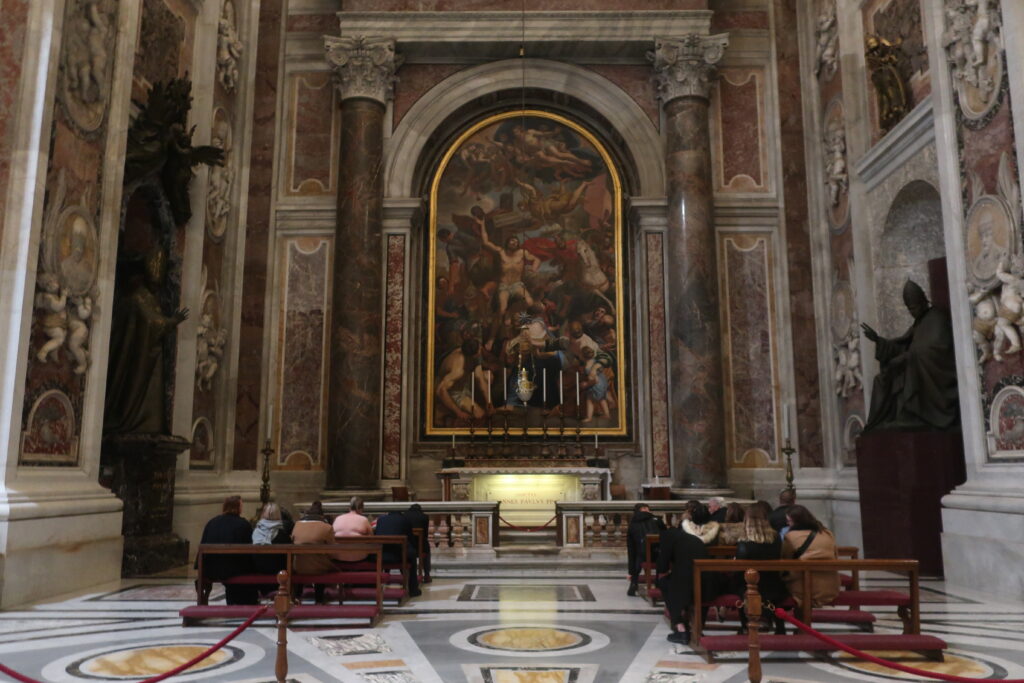
John Paul II is one of the religious figures I admire.
I came to have a deep-seated respect for this man by Jerzy BuazinskiFrom Krakow to Rome.This was the reason for the biography of the company.
I read this book and wept. I was struck by the sheer scale of John Paul II.
The tomb of John Paul II is located in St. Peter's Basilica. In fact, I was looking forward to visiting the tomb of John Paul II the most during my stay in Rome.
I dare not describe what I felt and thought here. I spent a moment here that I will never forget.
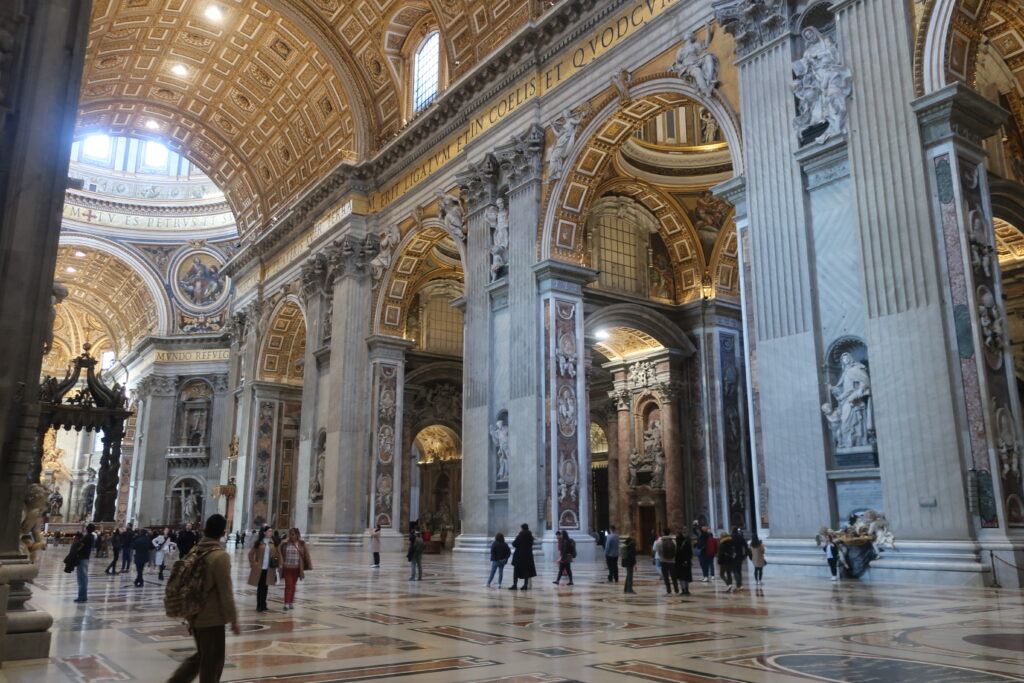
St. Peter's Basilica is still a special place.
No matter how many times I come here, I am always impressed. And it was Bernini who created this wonderful space. The cathedral is the highlight of a Bernini visit. I hope many people can experience the theatrical space created by Bernini.
be unbroken
*The following photos are my Bernini notes. I hope you will find them useful.
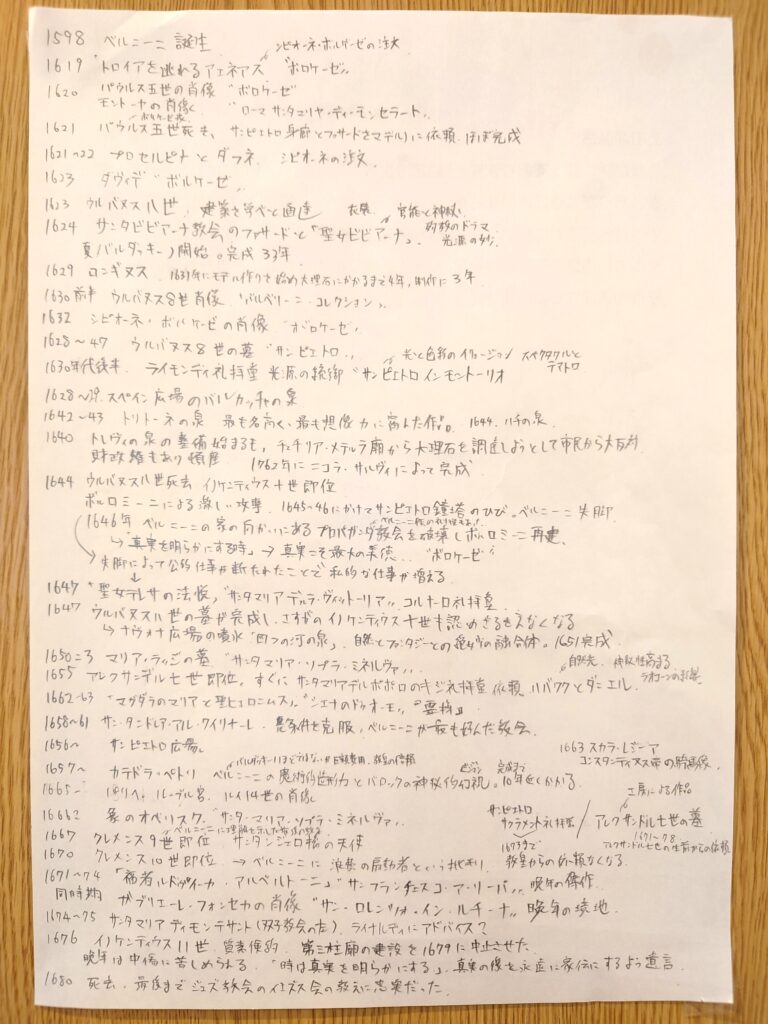
*The list of articles in the "Rome Travel Journal" can be found atCategory page hereindicates direction or goal (e.g. "to")
*Please visit this category page for recommended books to learn about Rome and Italy.
The Rise and Fall of the Roman Empire, the Vatican, and Roman Catholicism."
The Italian Renaissance and the Revolution in Knowledge."
Next Article.
Click here to read the previous article.
Related Articles











